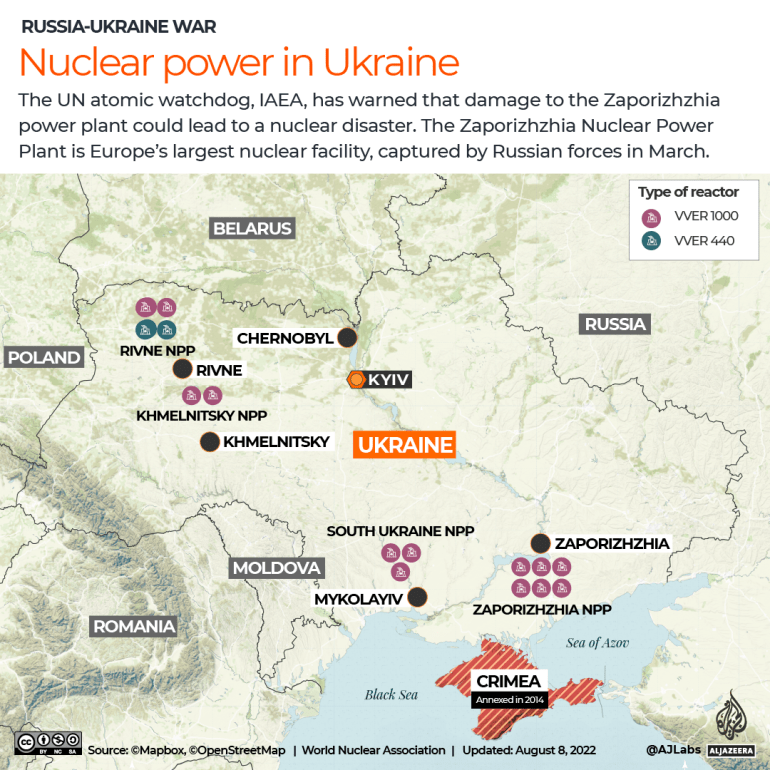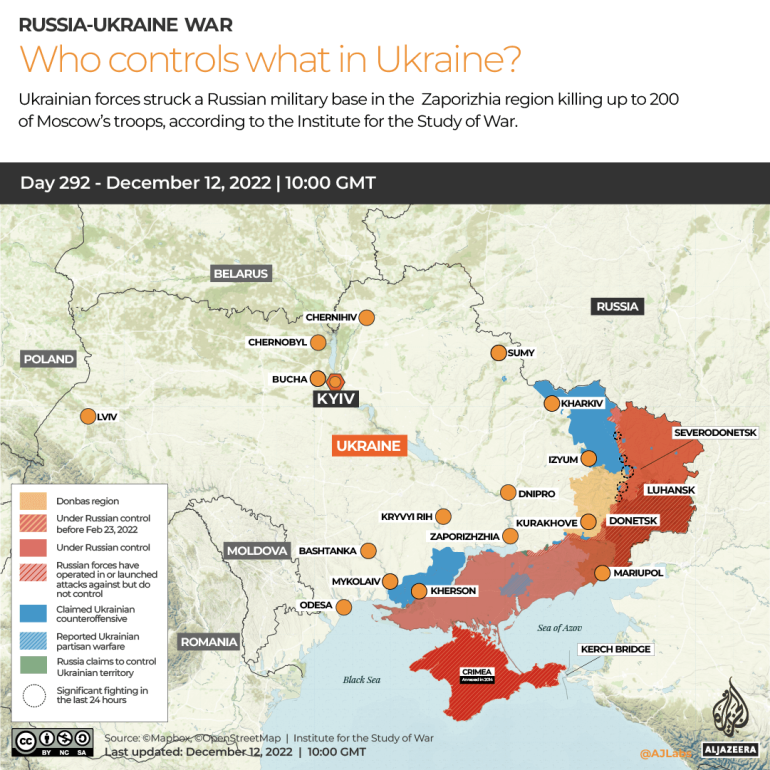Updates?
I haven’t been very active lately, but I’ve still been following the war. Here’s something, many months after the last update!
July 23rd, 2023
- F-16 training will be starting for Ukrainian pilots in August. We may see the planes up in the sky by next years.
- The port city of Odesa was recently attacked. As of writing this, one person is dead, and 19 others injured, including children.

https://www.aljazeera.com/wp-content/uploads/2022/12/INTERACTIVE-What-weapons-is-US-sending-Ukraine-.png.webp?w=770&resize=770%2C770&quality=80
https://d.newsweek.com/en/full/2260913/isw-map.webp?w=790&f=41d2d6d5c81d082452877b389d2d166f
- It is believed that Russia has drafted a plan to create a false flag attack on the ZNPP, the Zaporizhzhia Nuclear Power Plant.
- The IAEA experts sent to the NPP have seen transport trucks in the turbine halls of Units 1, 2, and 4, but no evidence of explosives. However, they have not been granted access to the roofs of the reactors and their turbine halls, which they have repeatedly requested access to. It continues to be of interest to them.
-
However, a satellite image showed mysterious objects on the roof of one of the reactors, reactor 4. They have not been able to identify what these objects are, and satellite images from the past year and a half were examined; these objects were not there before.

- The IAEA team reported that the available water supply remains relatively stable, with the water level decreasing by around 1 centimetre per day due to usage and evaporation. The site continues to have sufficient water for some months.
- Since the Kakhovka dam was destroyed – leading to the disappearance of the huge reservoir as a reliable source of water – the Zaporizhzhya Nuclear Power Plant has been conducting a range of activities to both secure the remaining bodies of water and find new ones.
- Russians at the ZNPP recently tried to have the workers start up reactor 4, but the Ukrainian workers refused. 6 Russian workers have been brought to ZNPP in response.
Now, I’m going to dedicate the last bit of this update to talking about the ZNPP.
There’s a lot of misinformation, and it’s really easy to get swept up in it, and suffer anxiety from it, even if you live no where near the plant. I recommend following the IAEA’s updates on the situation, since their reports are unbiased, without any fearmongering.
https://www.iaea.org/news?year%5Bvalue%5D%5Byear%5D=&type=3243&topics=All&keywords=Ukraine
The issue at the ZNPP is unique, since never before has it truly happened like this. Russian forces, in a way, are using the ZNPP as a shield. They’d done similar things at Chornobyl, although that was different, since as we know the reactors there are completely shut down, and is in the process of decommissioning, as opposed to ZNPP in active use.
If Russia, or anyone does detonate explosives in the plant, this would be classified as an attack of terror, and warrant NATO response. I have scoured the Internet and haven’t seen anything that points to this being a high chance of occurrence, but we do know that there are existing plans for a potential attack.
It is unlikely that if anything happens, it would be a Chornobyl level event, as the plant is in cold shutdown. I did note that earlier they tried to start up one of the reactors, however.

Potential ways the NPP could be hit:
Alberque said there are four areas in the plant that Russia could be planning to attack: They could blow up the dry fuel storage, blow up the wet fuel storage, blow up one of the reactor buildings itself or try to melt the nuclear fuel that's still in the reactor.
"If they hit it from the outside and tried to say that Ukraine did it, they'd be hitting a reactor building that's incredibly well reinforced. These are not the RBMK reactors that Chernobyl was. These are DVRs, they have very big containment on the outside – lots of concrete. So you'd have to hit it with a lot of weaponry in order to do any damage that's of any significance to chance release," Alberque said.
"None of these scenarios rise to the level of a Fukushima or Chernobyl," Alberque said, referring to two infamous meltdowns at nuclear power plants, "unless they blow it up right from the inside and they guard it to make sure that no one can do anything about it for a couple of weeks and the fuel builds up and then explodes."
With the IAEA on site, Alberque said this is not currently a credible scenario. Alberque said the IAEA is monitoring the reactors very closely and it is still a fully functioning facility so it would be hard to plan such an explosion from inside without IAEA's on-site team seeing it.
The least dangerous of the four scenarios, blowing up the dry fuel storage, would impact people in the direct downwind, who would have an increased risk of cancer in their lifetime, Alberque said.
The most dangerous scenario would be to blow up the reactor vessel inside the building itself, Alberque said. This would be similar to what Russia did when it blew up Kakhovka Dam, a strategically vital dam and hydroelectric power plant, in June.
Kakhovka was also described as a false flag operation months before it happened.
"You're not talking about opening a live reactor the way that Chernobyl was, but you would be burning the fuel institute, probably in the hopes that it melts through the floor and causes some Fukushima-type event. But that would take a long time to occur," Alberque said.
On the potential damage:
Alberque said any explosion at Zaporizhzhia would be far less damaging than the dam that was blown up by Russia last month.
"If something bad does happen, it's not even going to be as devastating as that flood was. That flood was far more devastating, far bigger environmental impact, far more deaths than anything that they could do with the reactor now," Alberque said.
The American Nuclear Society released similar guidance, saying the reactors being shutdown limits the risk of fallout from an explosion. "Our experts have carefully considered 'worst case scenarios,' including bombardment and deliberate sabotage of the reactors and spent fuel storage canisters. They cannot foresee a situation that would result in radiation-related health consequences to the public," the American Nuclear Society said in a statement this week.
The American Nuclear Society said with the reactors shutdown for over 10 months, they are not making enough heat to prompt a radiological release. "ZNPP is designed to withstand natural and man-made hazards. Thick, steel-reinforced concrete containment buildings protect the reactor cores and are designed to keep any radioactive materials isolated from the environment," the American Nuclear Society said.
"In the unlikely event that containment structures were breached, any potential release of radiological material would be restricted to the immediate area surrounding the reactors. In this regard, any comparison between ZNPP and 'Chernobyl' or 'Fukushima' is both inaccurate and misleading," according to the American Nuclear Society.
Alberque said people living within 20 miles of the reactor should be aware of safety procedures. In the event of a warning that something has occurred, they should go inside, close the windows and try to recirculate air from the inside. Anyone who is outside should completely remove their clothes and completely wash down everything as quickly as possible.
I dislike fear mongering, and I personally know how easy it is to get into a panic over something, so I tried to find credible experts on the situation. While it is worrying, it’s unlikely that if anything happens, it’ll be a Chornobyl or Fukushima level catastrophe, or a level 7 on the International Nuclear Event Scale. And either way, it’ll be hard for the Russians to plan anything without being noticed.












